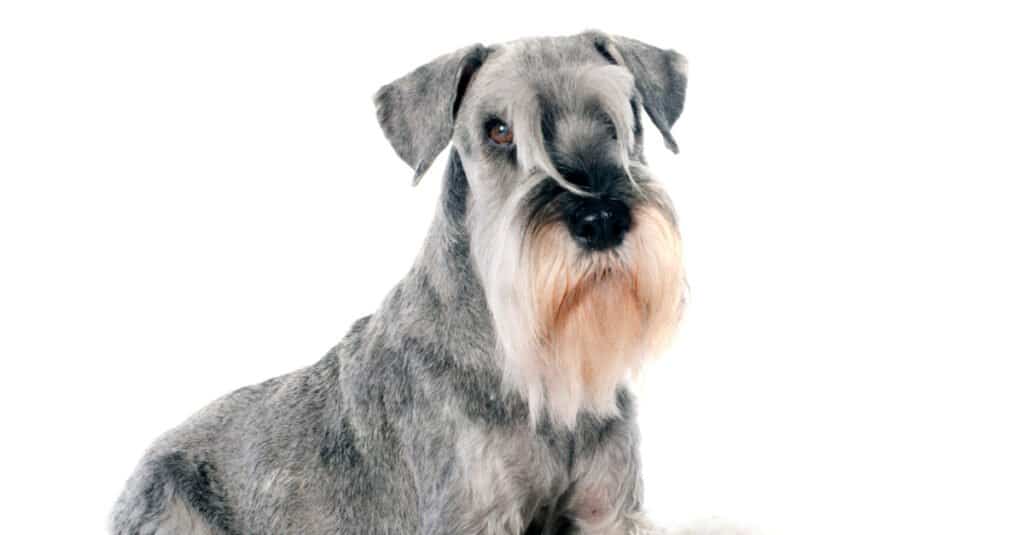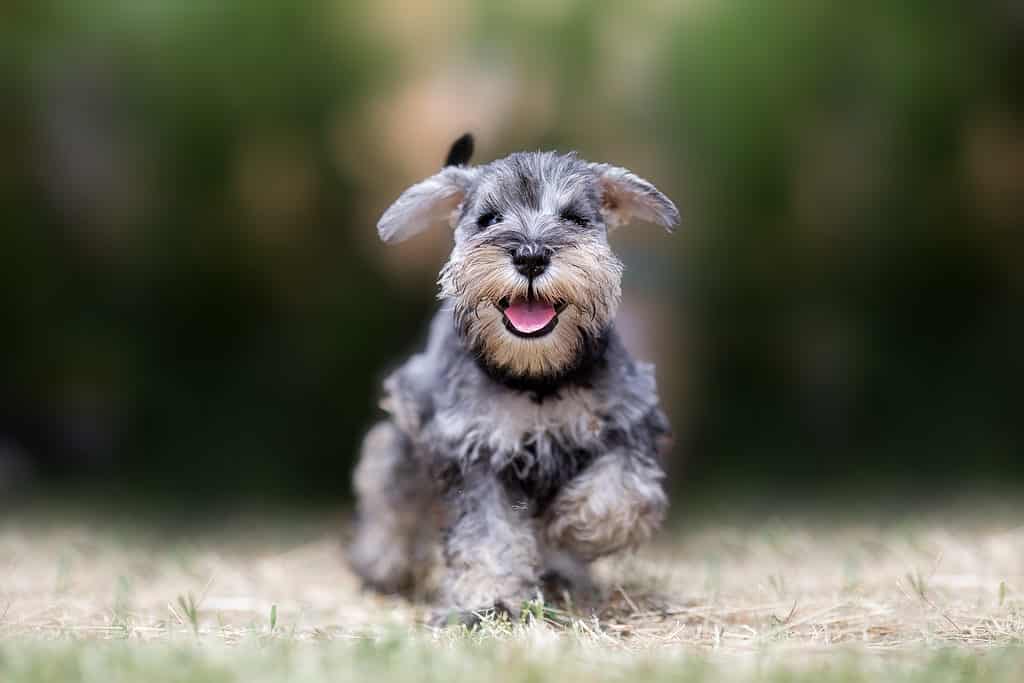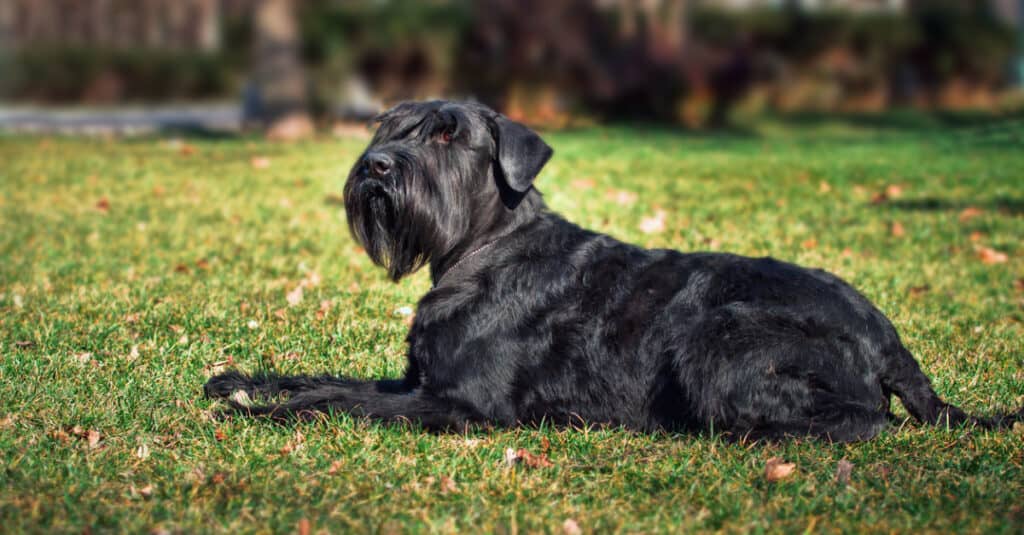A schnauzer is a breed of dog that originated in Germany. They are known for their distinctive appearance, which includes a wiry coat and eyebrows that give them a human-like expression. There are three sizes of schnauzers: miniature, standard, and giant.
The miniature schnauzer typically weighs between 11-20 pounds and stands about 12-14 inches tall at the shoulder. They have a square-shaped heads with bushy eyebrows, dark round eyes, and long whiskers on their muzzle. Their fur is usually black or salt-and-pepper colored.
The standard schnauzer is larger than the miniature variety but smaller than the giant schnauzer. They weigh between 35-50 pounds and stand about 17-20 inches tall at the shoulder. Their head is also square-shaped with bushy eyebrows, but they have more defined musculature throughout their body compared to their smaller counterpart.
Lastly, the giant schnauzer can weigh up to 95 pounds and stand around 23-28 inches tall at the shoulder. As expected from its name, it’s significantly bigger than both other varieties, with similar features such as bushy eyebrows and a square-shaped head with long whiskers on its muzzle.
Breeding and History: What Were Schnauzers Bred For?

Schnauzers were bred to be all-purpose farm helpers and are great at multiple skills.
©cynoclub/Shutterstock.com
The standard schnauzer is the original breed of the three types of schnauzers, which also includes miniature and giant breeds. Referred to as Mittelschnauzer or “medium schnauzer” in Germany, this versatile breed was initially bred for farm work during a time when agriculture relied solely on manual labor. Farmers across different regions were seeking all-purpose helpers that could perform various tasks around their farms.
As such, farmers in Germany selectively bred dogs to create an ideal farm dog that was adaptable and versatile enough to assist with many different tasks. While other countries developed distinctive breeds like the Kerry Blue Terrier (Ireland), Rat Terrier (United States), and Belgian Tervuren based on similar needs, German farmers found their solution in what eventually became known as the schnauzer.
Schnauzers, originally bred for their exceptional skills as herders, ratters, guardians, and hunters in the farm country of Bavaria during the Middle Ages, are now well-loved by families worldwide for being loyal companions with watchdog instincts. Their popularity beyond just farming purposes is attributed to their protective nature towards their owners.
One of the remarkable features of this adorable breed is its exceptional pedigree which showcases why it has remained a well-loved dog today. Despite bearing a superficial resemblance to several terrier breeds of Britain, schnauzers are a product of Continental herders and working dogs.
The multitasking abilities displayed by schnauzers made them an indispensable tool on farms where they performed various tasks, such as keeping rats away from crops and livestock while also serving as reliable guards against potential intruders or predators.
Their unique characteristics earned them widespread admiration among farmers, who eventually began breeding them selectively to enhance certain traits such as intelligence, loyalty, and alertness- all desirable qualities in any good farm dog.
Through careful breeding practices over time, schnauzers became more refined, resulting in three distinct sizes – miniature schnauzer, standard schnauzer, and giant schnauzer. These different sizes have made it possible for people with varying lifestyles to enjoy the company of these amazing dogs regardless of the living spaces available.
In conclusion, understanding the history behind how this breed came into existence highlights its exceptional pedigree while showcasing why it has remained a beloved dog.
SchnauzerTemperament

Schnauzers come in many sizes, but they are all smart and friendly in nature.
©Lunja/Shutterstock.com
As beloved companions, schnauzers are known for their sociable and friendly nature. They thrive on human interaction and enjoy spending time with their families. In addition to being great pets, they also make excellent watchdogs due to their natural alertness and protective instincts.
Schnauzers are also enthusiastic backyard squirrel chasers, thanks to their high energy levels and natural hunting abilities. This makes them a great choice for owners who live in rural areas or have large yards where their dogs can run around freely.
Despite their size, schnauzers are good with kids and have a reputation for being patient and gentle around children of all ages. They are loyal dogs who will go to great lengths to protect those they love.
However, it’s important for owners to approach training with a firm but gentle hand in order to get the best results from these intelligent dogs. Standards especially respond well to training when given consistent guidance from an early age.
To keep up with the physical needs of this breed, owners must provide outlets for their dog’s upbeat athleticism. Regular exercise is crucial in preventing boredom-related behavior problems such as excessive barking or destructive chewing.
Overall, schnauzers bring joy into the lives of many as wonderful companions that excel at various activities while serving as reliable protectors of those they hold dear.
Exercise

Schnauzers are high-energy dogs that require a large amount of physical activity.
©everydoghasastory/Shutterstock.com
Schnauzers are known for their high energy levels and love for physical activity. These dogs thrive on regular exercise, which not only helps keep them physically fit but also provides important mental stimulation that is vital to their overall well-being.
One of the things that make schnauzers such great companions is their innate desire to be part of the family unit. They do not do well when left alone or tied up in a yard for extended periods, as they crave human interaction and enjoy being involved in family activities. This means that owners must be prepared to dedicate time each day to play with and exercise their schnauzer.
Long hikes are one of the best ways to keep a schnauzer happy and healthy. These dogs have plenty of stamina and can easily handle long walks through rugged terrain or over uneven ground. Additionally, most schnauzers excel at performance sports like agility and herding. As natural hunters with a strong prey drive, these activities provide an outlet for their instincts while allowing them to bond further with their owners.
Schnauzer Grooming

Schnauzers have double coats that require regular grooming.
©Ihar Halavach/Shutterstock.com
As a schnauzer owner, it is important to be aware of the grooming needs that come along with this breed. Regular grooming tasks, such as washing the beard and legs, dental maintenance, cleaning in between the toes, and nail trims, should be done on a weekly basis to maintain their hygiene.
Schnauzers have a double coat which requires special attention when it comes to clipping or hand-stripping. In order to preserve the coarse, wiry outer coat’s excellent water-resistant properties, hand-stripping is recommended instead of clipping. Clipping can result in more shedding of hair in the house and make the coat soft while also lightening its color with each subsequent clip. However, once a coat has been hand-stripped properly, regular brushing and plucking out long hairs can help maintain its appearance for an extended period without requiring frequent trips back to the groomer’s chair. Overall, being mindful of these grooming needs will not only keep your schnauzer looking his best but also ensure he stays healthy and happy throughout his life.
Schnauzer Health
Schnauzers are a very healthy breed of dog. They are mostly disease free! As always, regular vet visits are recommended to rule out hip dysplasia and cardiomyopathy. There is even a new DNA test for cardiomyopathy, and it is recommended that all breeders implement this new test in their breeding practices.
Training

Schnauzers are highly-intelligent and can learn many tricks and games.
©iStock.com/Voltgroup
One of the key factors in training a schnauzer is early socialization during puppyhood. Schnauzers have been bred for their intelligence, which makes them quick learners and easily adaptable to new situations. However, this same trait also means that they can get bored with repetitive exercises and may become uninterested or even resistant to further training.
Over-training can be a problem with schnauzers as they are too smart for their own good. After just a few repetitions of an exercise, they may lose interest and look at the trainer as though the trainer is ridiculous. This behavior can be frustrating for trainers who need to keep these dogs engaged in order to achieve successful results.
Despite their natural intelligence, it is important that owners provide consistent training for their schnauzers. If they aren’t given guidance, these dogs will learn on their own, but not necessarily what the owner wants them to learn! A well-trained schnauzer will be more obedient and responsive to commands from its owner than one left without proper instruction.
In conclusion, while schnauzers possess many admirable qualities, such as being intelligent and crafty animals (traits that make them excellent working dogs), overtraining should be avoided so that the dog remains interested in learning new things. By providing early socialization combined with appropriate levels of stimulation throughout adulthood, owners can help ensure that their pets continue demonstrating positive behaviors towards other people and animals.
The photo featured at the top of this post is © Rita_Kochmarjova/Shutterstock.com
Ready to discover the top 10 cutest dog breeds in the entire world?
How about the fastest dogs, the largest dogs and those that are -- quite frankly -- just the kindest dogs on the planet? Each day, AZ Animals sends out lists just like this to our thousands of email subscribers. And the best part? It's FREE. Join today by entering your email below.
Thank you for reading! Have some feedback for us? Contact the AZ Animals editorial team.






